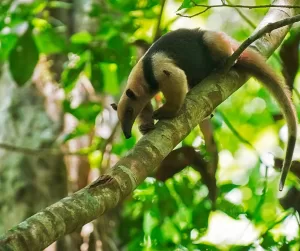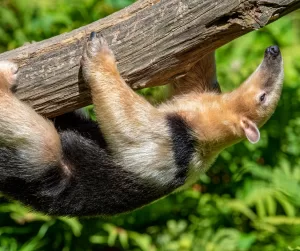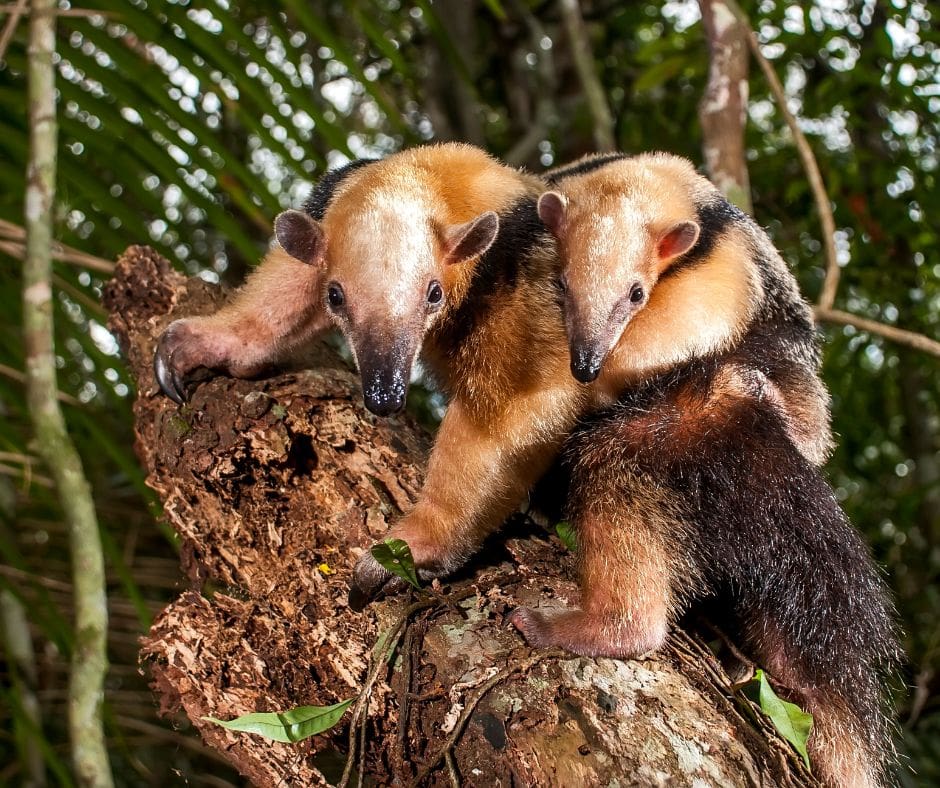Costa Rica is home to a fascinating creature: the Tamandua, or lesser anteater. This small, tree-dwelling mammal is a vital part of Costa Rica’s ecosystem, contributing in ways that often go unnoticed.
A Unique Creature in the Rainforest
The Tamandua is part of the anteater family, but it’s distinct from its larger cousin, the giant anteater. It’s smaller, with a body length of about 47-77 cm, and possesses a prehensile tail that aids in climbing trees. This tail, almost as long as its body, helps the Tamandua navigate the rainforest canopy with ease. Their fur, a mix of beige and black, provides natural camouflage in the dappled sunlight of the rainforests.
Tamanduas are solitary creatures, primarily nocturnal, and have a keen sense of smell to compensate for their poor eyesight. This sense of smell is crucial in locating their primary food source: ants and termites.

Environmental Contributions
Pest Control
Tamanduas play a significant role in pest control. They feed on ants and termites, which are abundant in Costa Rican forests. By controlling these insect populations, Tamanduas help maintain a balance in the ecosystem. Without this natural form of pest control, ant and termite populations could grow unchecked, potentially leading to crop damage and other ecological imbalances.
Forest Health
Their feeding habits also contribute to the health of the forest. By consuming wood-boring insects like termites, Tamanduas help protect trees from excessive damage. This protection allows the trees to continue playing their vital roles in the ecosystem, such as carbon sequestration, oxygen production, and providing habitats for other species.

Soil Aeration
As Tamanduas dig into ant hills and termite mounds, they inadvertently aerate the soil. This aeration improves soil quality, promoting better water absorption and nutrient distribution. Healthier soil supports more robust plant growth, which in turn benefits the entire forest ecosystem.
Challenges and Conservation
Despite their importance, Tamanduas face challenges. Habitat loss due to deforestation and human encroachment is a significant threat. Additionally, they are often misunderstood and mistakenly feared by locals due to their clawed forelimbs and secretive nature.
Conservation efforts are crucial to ensure the survival of the Tamandua. Protecting their natural habitats and educating the public about the ecological benefits of these creatures are vital steps in this direction. Wildlife sanctuaries and national parks in Costa Rica play a crucial role in preserving the habitats of Tamanduas and other native species.
The Tamandua, a lesser-known but crucial inhabitant of Costa Rica’s rainforests, plays a vital role in maintaining ecological balance. Its contributions to pest control, forest health, and soil quality are invaluable. By understanding and protecting these unique creatures, we can ensure the continued health and diversity of Costa Rica’s ecosystems.
Remember to share your love for Costa Rica’s wildlife and follow more amazing stories with #howlermag and #howlermagazine. Let’s appreciate and protect these incredible creatures whose home is this beautiful country.
More related articles
JTNDaWZyYW1lJTIwd2lkdGglM0QlMjI1NjAlMjIlMjBoZWlnaHQlM0QlMjIzMTUlMjIlMjBzcmMlM0QlMjJodHRwcyUzQSUyRiUyRnd3dy55b3V0dWJlLmNvbSUyRmVtYmVkJTJGQXNsYUF1R2tjcjglM0ZzaSUzRFZnU0NMSGgtcDJZbFZlSWUlMjIlMjB0aXRsZSUzRCUyMllvdVR1YmUlMjB2aWRlbyUyMHBsYXllciUyMiUyMGZyYW1lYm9yZGVyJTNEJTIyMCUyMiUyMGFsbG93JTNEJTIyYWNjZWxlcm9tZXRlciUzQiUyMGF1dG9wbGF5JTNCJTIwY2xpcGJvYXJkLXdyaXRlJTNCJTIwZW5jcnlwdGVkLW1lZGlhJTNCJTIwZ3lyb3Njb3BlJTNCJTIwcGljdHVyZS1pbi1waWN0dXJlJTNCJTIwd2ViLXNoYXJlJTIyJTIwYWxsb3dmdWxsc2NyZWVuJTNFJTNDJTJGaWZyYW1lJTNF






